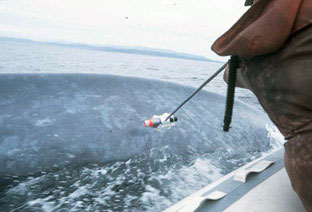 Photo Credit: John CalambokidisChances are, if you've ever been swimming, you understand that it's hard to dive deep. But marine mammals do it all the time -- and they dive to depths beyond our imagination. Sperm whales, beaked whales, elephant seals all have an amazing ability for deep-diving, and along with that, fascinating specializations to their anatomy and physiology. Decades of research have demonstrated that diving mammals undergo a reduction in heartrate (bradycardia), a shunting of blood from the periphery to the core of their body, and have innovative features for preventing lung collapse and maximizing heat storage and blood oxygen. These features seem to have evolved multiple times in marine mammals and, interestingly, marine mammals of all sizes, from seals to blue whales, use the same energy-saving behaviors.
Photo Credit: John CalambokidisChances are, if you've ever been swimming, you understand that it's hard to dive deep. But marine mammals do it all the time -- and they dive to depths beyond our imagination. Sperm whales, beaked whales, elephant seals all have an amazing ability for deep-diving, and along with that, fascinating specializations to their anatomy and physiology. Decades of research have demonstrated that diving mammals undergo a reduction in heartrate (bradycardia), a shunting of blood from the periphery to the core of their body, and have innovative features for preventing lung collapse and maximizing heat storage and blood oxygen. These features seem to have evolved multiple times in marine mammals and, interestingly, marine mammals of all sizes, from seals to blue whales, use the same energy-saving behaviors.
One of the reasons why we know so many details about the diving of oceanic mammals has to do with a wonderful device called the Crittercam. If you've seen "March of the Penguins" or if you've seen natural history films in the past decade, you've probably seen footage shot by the Crittercam: it's a small, lightweight camera that can be attached (via a harness or a suction cup) to wild animals. It's no trivial task to accomplish, but the results have produced stunning insights into the behavior of not just marine mammals, but many other land animals too. Check out an upcoming conference in Washington, D.C., all about Crittercam (and other so-called animal-borne imaging systems).
![]() Nick Pyenson is a PhD candidate at the University of California, Berkeley, in the department of integrative biology and the museum of paleontology.
Nick Pyenson is a PhD candidate at the University of California, Berkeley, in the department of integrative biology and the museum of paleontology.
